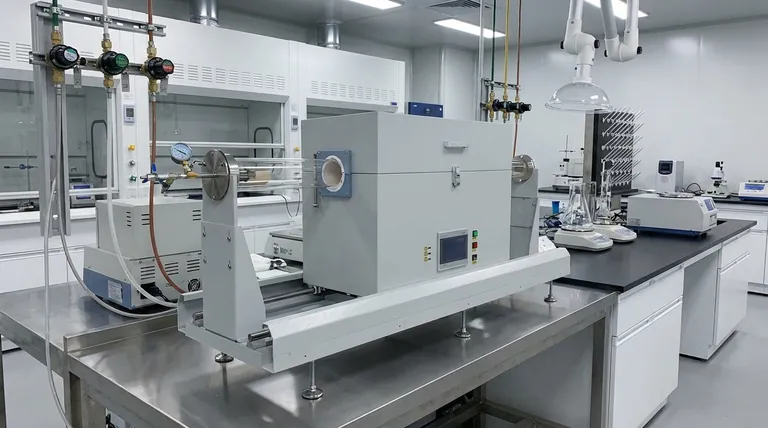The temperature resistance of a ceramic tube is not a single value; it varies dramatically depending on the specific material. A common transparent quartz tube can typically be used up to 1100°C (2012°F), while a more advanced Mullite ceramic tube can operate safely at temperatures as high as 1600°C (2900°F).
Your central challenge is not finding a single number, but understanding that "ceramic" is a broad category. The correct choice depends entirely on matching the specific material's properties—like Mullite or Quartz—to your application's maximum temperature, atmosphere, and thermal cycling needs.

Why "Ceramic" Isn't Specific Enough
When selecting a tube for a high-temperature process, thinking in terms of specific materials is critical. The generic term "ceramic" can be misleading, as it covers a vast family of materials with widely different performance characteristics.
The Broad Family of Technical Ceramics
Technical ceramics are engineered for demanding environments. Materials like quartz, mullite, and alumina are all types of ceramics, but their temperature limits and other properties are not interchangeable.
Quartz: The Common Workhorse
For many laboratory and industrial applications, transparent quartz tubes are a standard choice. They offer excellent thermal stability and optical clarity for processes running up to a maximum of 1100°C (2012°F).
Mullite: For Higher Temperature Applications
When temperatures exceed the limits of quartz, advanced ceramics are required. Mullite (C30 Ceramic) is an excellent example, rated for continuous operation up to 1600°C (2900°F). This capability makes it suitable for high-temperature tube furnaces that operate in the 1400°C to 1800°C range.
Factors Beyond Maximum Temperature
The maximum temperature rating is only the starting point. The actual safe operating limit is heavily influenced by the specific conditions inside the tube.
The Impact of Atmosphere
A tube's temperature resistance is often rated for use in air. If you are using a reactive atmosphere, this rating can decrease significantly.
For example, a mullite tube that is impervious in air up to 1650°C (3000°F) may only be rated for use in dry hydrogen or carbon monoxide up to 1400°C (2550°F).
Thermal Shock Resistance
Thermal shock is the stress a material endures during rapid temperature changes. Materials with a low rate of thermal expansion, like mullite, have superior resistance to cracking during fast heating or cooling cycles.
Chemical Compatibility
The chemical environment also plays a crucial role. Some ceramics offer better resistance to certain compounds, such as the good resistance to acid slag noted in mullite. Always verify that the tube material is compatible with the chemicals in your process.
Understanding the Trade-offs
Selecting a higher-performance material often involves compromises in other areas.
Performance vs. Cost
As a general rule, materials with higher temperature ratings and superior chemical resistance are more expensive. A quartz tube is sufficient and more cost-effective if your process never exceeds 1100°C.
Brittleness and Handling
All ceramic materials are inherently brittle compared to metals. Careful handling is always required, but a material chosen for extreme temperature performance may require even greater attention to avoid mechanical stress and fractures.
Lower Temperature Materials
Be aware that the term "ceramic" is sometimes used loosely. Some products, possibly polymer-ceramic composites, may have much lower temperature limits, such as -40°C to +260°C. These are not suitable for high-temperature furnace applications.
How to Select the Right Ceramic Tube
Your choice should be a direct reflection of your operational needs. Use these points to guide your decision-making process.
- If your primary focus is general use up to 1100°C: A standard transparent quartz tube is often the most cost-effective and suitable choice.
- If your primary focus is high-temperature operation (1100°C to 1600°C): You need to specify an advanced ceramic like Mullite and confirm its rating meets your requirements.
- If your primary focus is operating in a reactive atmosphere (e.g., hydrogen): You must verify the tube's de-rated maximum temperature for that specific environment, as it will be lower than its rating in air.
- If your primary focus is processes with rapid heating/cooling cycles: Prioritize a material with excellent thermal shock resistance, which is indicated by a low coefficient of thermal expansion.
Matching the specific ceramic material to your precise operating conditions is the key to ensuring a safe and reliable process.
Summary Table:
| Material | Max Temperature (Air) | Key Characteristics |
|---|---|---|
| Quartz | 1100°C (2012°F) | Transparent, cost-effective for general use |
| Mullite | 1600°C (2900°F) | High-temperature stability, good thermal shock resistance |
Struggling to select the right high-temperature tube for your furnace?
At KINTEK, we specialize in matching the perfect lab equipment and consumables—like quartz and mullite ceramic tubes—to your specific application's temperature, atmosphere, and thermal cycling requirements. Our experts ensure you get a safe, reliable, and efficient solution.
Contact us today to discuss your needs and let KINTEK provide the optimal ceramic tube for your laboratory. Get in touch via our contact form
Visual Guide

Related Products
- Laboratory Rapid Thermal Processing (RTP) Quartz Tube Furnace
- 1400℃ Laboratory High Temperature Tube Furnace with Alumina Tube
- Multi-zone Laboratory Tube Furnace
- 1700℃ Laboratory High Temperature Tube Furnace with Alumina Tube
- Vertical Laboratory Tube Furnace
People Also Ask
- What is the temperature of a quartz tube furnace? Master the Limits for Safe, High-Temp Operation
- What is the temperature rating of a quartz tube? Maximize Performance & Avoid Failure
- What does a quartz tube do? Create a Pure, High-Temp Environment for Critical Processes
- What happens when quartz is heated? A Guide to Its Critical Phase Transitions and Uses
- What is quartz tube heating? Achieve Instant, Targeted Heat with Infrared Radiation



















